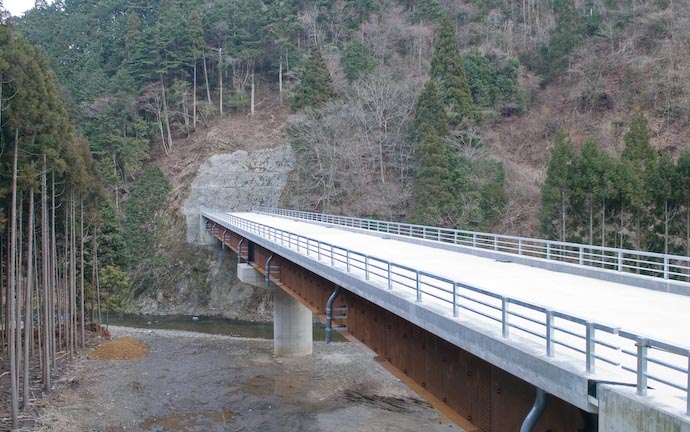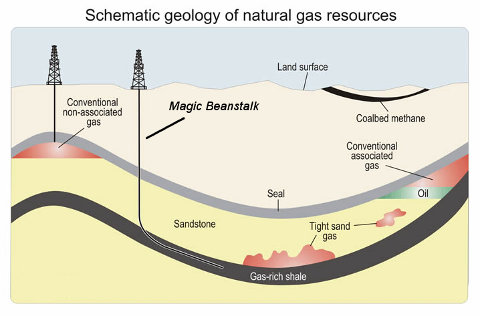Environment & Energy
Related: About this forumWhy Natural Gas is a Bridge to Nowhere

"Chair of American Gas Association, 2008: 'Natural gas will be the bridge fuel to the future…. The electric industry is expected to turn to natural gas as a bridge until clean coal and nuclear generation are available.'
It’s the longest bridge in history! Heck, the Golden Gate Bridge only took 4 years to build!
The President will be touting natural gas in his State of the Union address tonight, according to sources. Nothing wrong with touting gas — if you also tout a rising carbon price, which the president once did but no longer does.
<>
"...Building lots of new gas plants doesn’t make much sense since we need to sharply reduce greenhouse gas emissions in the next few decades if we’re to have any chance to avoid catastrophic global warming. We don’t want new gas plants to displace new renewables, like solar and wind, which are going to be the some of the biggest, sustainable job creating industries of the century."
http://theenergycollective.com/josephromm/74968/natural-gas-bridge-nowhere-absent-serious-price-global-warming-pollution?utm_source=feedburner&utm_medium=feed&utm_campaign=The+Energy+Collective+%28all+posts%29
Kolesar
(31,182 posts)After efficiency improvements and renewals accomplished by President Obama's 2009 stimulus bill, he describes how else to his the 2020 target for CO2 reductions:
There really is only one obvious choice — cofiring biomass in those same coal plants (see “If Obama stops dirty coal, as he must, what will replace it? Part 2: An intro to biomass cofiring.” After all, those plans have already been sited, built, and largely paid for. They are already connected to transmission and the country’s freight train delivery system!
You just need to pay for collecting the biomass and shipping it to the power plant. That’s why a 1997 study by five U.S. national laboratories that I oversaw concluded biomass cofiring was the single biggest potential contributor to near-term greenhouse gas reductions of any renewable energy strategy.
We found that within 13 years (2010), you get get maybe a 60 million ton reduction in CO2 emissions and 3 times that by 2020 (again, starting in 1997). Let’s say we try hard and get 2% of the 2020 target with cofiring.
So we still need some 240 million metric tons of reductions more to hit the target. This requires switching, say, 350,000 gigawatt-hours of coal — maybe 50 GW (with 70% capacity factor) — to high-efficiency gas.
http://thinkprogress.org/romm/2009/06/10/204220/game-changer-part-2-why-unconventional-natural-gas-makes-the-2020-waxman-markey-target-so-damn-easy-and-cheap-to-meet/
That article was linked from the article in the original post.
Joe Romm is advocating gas fired "combined cycle" generation. Waste heat from the turbine would be used to make steam for additional electricity generation.
wtmusic
(39,166 posts)Joe was talking about reconfiguring existing plants. Although Obama's SOTU was not very explicit, 600,000 new jobs sounds like a lot of brand new generation.
Kolesar
(31,182 posts)Coal, biomass, natural gas?
wtmusic
(39,166 posts)hunter
(38,317 posts)
Kolesar
(31,182 posts)Congratulations
ht tp://izpics.com/hunter/2012/GasDepositDiagram.jpg
hunter
(38,317 posts)...and I could have done better with the typeface and resizing.
But that would be getting to the point where I'd expect someone to pay me, and frankly, I can't afford my own services.
Gregorian
(23,867 posts)They're evidently not much more than glorified hopes with little to back them up.
The "problem" is so much wider than just energy, we have to start talking about it sooner or later. I am now calling it the human bubble. We are only bailing it out.
Dead_Parrot
(14,478 posts)I see the estimate for Marcellus Shale just got slashed
OKIsItJustMe
(19,938 posts)Released: 8/23/2011 11:30:00 AM
…
[font size=3]The Marcellus Shale contains about 84 trillion cubic feet of undiscovered, technically recoverable natural gas and 3.4 billion barrels of undiscovered, technically recoverable natural gas liquids according to a new assessment by the U. S. Geological Survey (USGS).
These gas estimates are significantly more than the last USGS assessment of the Marcellus Shale in the Appalachian Basin in 2002, which estimated a mean of about 2 trillion cubic feet of gas (TCF) and 0.01 billion barrels of natural gas liquids.
The increase in undiscovered, technically recoverable resource is due to new geologic information and engineering data, as technological developments in producing unconventional resources have been significant in the last decade. This Marcellus Shale estimate is of unconventional (or continuous-type) gas resources.
Since the 1930's, almost every well drilled through the Marcellus found noticeable quantities of natural gas. However, in late 2004, the Marcellus was recognized as a potential reservoir rock, instead of just a regional source rock, meaning that the gas could be produced from it instead of just being a source for the gas. Technological improvements resulted in commercially viable gas production and the rapid development of a major, new continuous natural gas and natural gas liquids play in the Appalachian Basin, the oldest producing petroleum province in the United States.
This USGS assessment is an estimate of continuous gas and natural gas liquid accumulations in the Middle Devonian Marcellus Shale of the Appalachian Basin. The estimate of undiscovered natural gas ranges from 43.0 to 144.1 TCF (95 percent to 5 percent probability, respectively), and the estimate of natural gas liquids ranges from 1.6 to 6.2 billion barrels (95 percent to 5 percent probability, respectively). There are no conventional petroleum resources assessed in the Marcellus Shale of the Appalachian Basin.
These new estimates are for technically recoverable oil and gas resources, which are those quantities of oil and gas producible using currently available technology and industry practices, regardless of economic or accessibility considerations. As such, these estimates include resources beneath both onshore and offshore areas (such as Lake Erie) and beneath areas where accessibility may be limited by policy and regulations imposed by land managers and regulatory agencies.
…[/font][/font]
The DoE just updated their document, to be in line with the USGS estimate.
http://stateimpact.npr.org/pennsylvania/2011/08/24/department-of-energy-defers-to-u-s-g-s-on-shale-gas-estimates/
August 24, 2011 | 1:27 PM
By Susan Phillips
[font size=3]In a report released Tuesday, the United States Geological Survey increased its own calculations on the amount of natural gas within the Marcellus Shale. From their previous report published in 2002, the U.S.G.S amended its measurements of untapped shale gas 40 times higher.
But the 84 trillion cubic feet of natural gas the U.S.G.S says lies within the Marcellus Shale is far less than estimates made in July by the Energy Information Administration. The EIA reported the Marcellus Shale holds more than 400 trillion cubic feet of natural gas.
So, why the huge gap? A spokesman for the EIA says they haven’t yet figured that out. But, Jonathan Cogan tells StateImpactPA that the U.S.G.S is the gold standard when it comes to the final say on how much gas lies beneath Pennsylvania’s forests and farms.[/font][/font]
Dead_Parrot
(14,478 posts)USGS starts at 2, EIA starts at 400, and they meet in the middle. Sold.
For some reason, that two branches of the same government can have such wildly different estimates reminds me of this definition of an anomaly - "It's where you find your ass with one hand but not the other, so you know something's wrong."
OKIsItJustMe
(19,938 posts)The previous USGS estimate was released in 2002. In the meantime, the practice of high volume horizontal hydraulic fracturing for gas production was introduced.
http://www.dec.ny.gov/docs/materials_minerals_pdf/GWPCMarcellus.pdf
A renewed interest in the Marcellus Shale was initiated in 2003 when Range Resources-Appalachia, LLC drilled the first “new” Marcellus well in recent years and began experimenting with the techniques used in the Barnett. This effort resulted in reported production in Pennsylvania from the Marcellus in 2005. Since 2005, the expansion of Marcellus shale development has continued in Pennsylvania and the Appalachian Basin. …
New methods of production meant that more gas was, “technically recoverable.” That was a big factor in the large increase in the USGS estimate of “undiscovered, technically recoverable natural gas.”
The difference between the EIA and USGS estimates for “undiscovered” gas I think is easily understood, and the EIA (wisely in my opinion) accepted the USGS estimates.
Kolesar
(31,182 posts)...way optimistic. It was a PR gimmick to get public and government support. I think that is what you are referring to about "predictions".
Gregorian
(23,867 posts)It was probably ResonanceFM. A great little radio station out of London